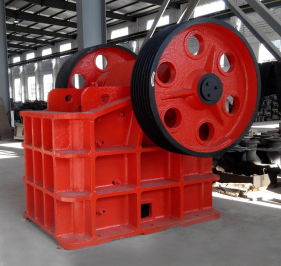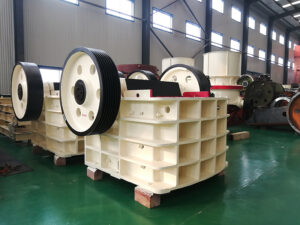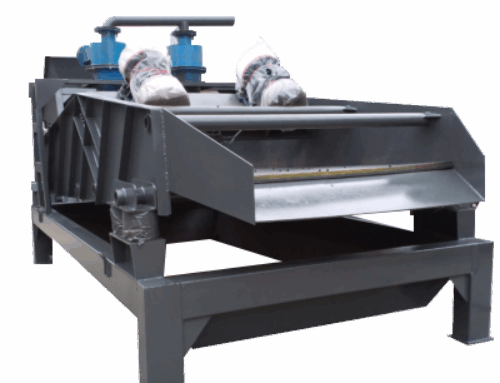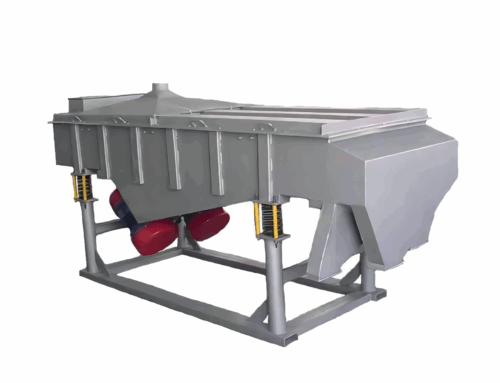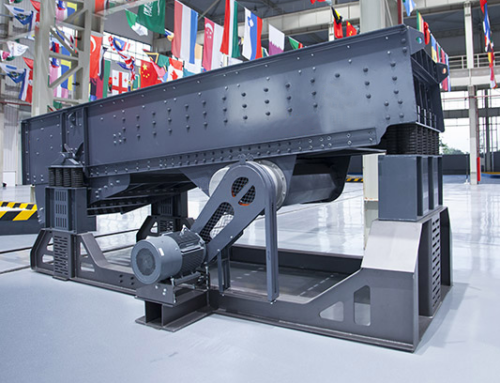In mining, building construction, road construction and many other industries, the crusher as a key equipment, its output is directly related to the progress of the project and the economic benefits of enterprises. However, the output of the crusher is not fixed, but is affected by a variety of factors. It is of great significance to explore these factors in depth to optimise the efficiency of the crusher, improve the output and reduce the production cost. Next, we will analyse in detail the factors affecting crusher output from various aspects.
一.The equipment’s own performance factors
1.Crusher type
Different types of crushers are suitable for different crushing scenarios and materials, and their working principles and structural characteristics determine the difference in output. For example, jaw crusher mainly crushes materials through the mutual extrusion and bending of movable jaw and fixed jaw, which has the advantages of simple structure, reliable work and strong adaptability, and is commonly used in coarse crushing operation, but due to the limitation of its working mode, the output is relatively limited when dealing with a large amount of materials. The cone crusher adopts the principle of laminar crushing, squeezing materials through the movement of the rolling wall to the crushing wall, with large crushing ratio and high efficiency, especially suitable for medium and fine crushing of materials with high hardness, and the output performance is more outstanding in the case of large handling capacity and high requirements for product size. Impact crusher, on the other hand, makes use of the high-speed rotating impeller to throw out the materials and collide with the impact plate and other parts to crush them, which is suitable for the production of mechanism sand and the processing of brittle materials with medium hardness or below, and can achieve higher output under specific working conditions. Therefore, choosing the right type of crusher according to the material characteristics and production requirements is the basis for ensuring the output.
2.Equipment specifications and models
For the same type of crusher, there are significant differences in production capacity among different specifications and models. Generally speaking, the larger the specification of the crusher, the larger its crushing chamber volume, and the more material can be processed per unit time. For example, a large jaw crusher has a larger inlet size, which can handle larger lumps of material at one time, and is equipped with a more powerful motor, which can provide stronger crushing power and thus achieve a higher output.
3.Wear and tear of crushing parts
The crushing parts of the crusher, such as jaws, hammerheads, crushing walls, etc., will wear out in the long-term working process. When these parts wear to a certain extent, the shape and size of the crushing chamber will change, resulting in the change of the trajectory of the material in the crushing chamber, the crushing effect deteriorates and the output decreases. For example, when the jaw plate of the jaw crusher is worn out, its tooth shape will become blunt, and its ability of biting and crushing the material will be weakened, making it difficult for the material to be crushed effectively, and it needs to be crushed several times to reach the qualified size, thus reducing the output per unit of time. After the hammer head is worn, its striking force and crushing effect will also be greatly reduced, affecting the working efficiency of the crusher. Therefore, regular inspection and replacement of crushing parts with serious wear is an important measure to maintain stable output of the crusher.
二.The material characteristics of factors
1.Material hardness
Material hardness is one of the important factors affecting the output of the crusher. Materials with high hardness, such as granite, quartzite, etc., are difficult to crush and need to consume more energy in order to crush them into qualified size products. During the crushing process, the crusher needs to exert more pressure or impact force, resulting in increased workload of the equipment, lower crushing efficiency, and a corresponding reduction in output. In contrast, materials with lower hardness, such as limestone and gypsum, are relatively easy to crush, and the crusher is able to work with higher efficiency and higher output.
2.Material humidity
Material humidity has a significant impact on crusher output. When material humidity is high, the material tends to stick to the crushing components and conveying equipment, causing blockages and affecting the normal flow of material and the crushing process. For example, when dealing with wet clay, the clay will form mud clusters in the crushing chamber of the jaw crusher, blocking the inlet and outlet ports, resulting in the crusher not being able to work properly and a significant drop in output. In addition, materials with high humidity will be more difficult to crush during the crushing process due to the increased bonding between the particles, which further reduces the crushing efficiency. Generally speaking, the moisture content of materials should be controlled within a certain range to ensure the normal operation of the crusher and stable output.
3.Material size composition
The particle size composition of the material is directly related to the feeding situation and crushing process of the crusher. If the proportion of large materials in the feed is too high, the crusher needs to spend more time and energy to crush them, which will lead to lower efficiency and reduced output. On the contrary, if the feed size is more uniform and smaller, the crusher can carry out the crushing operation more smoothly and the output will be increased accordingly. In addition, the high content of fines in the material will also affect the output, because fines are easy to form a pile in the crushing chamber, hindering the flow of materials and reducing the crushing effect. Therefore, proper screening and pre-treatment of the material before feeding and controlling the particle size composition of the material are conducive to improving the output of the crusher.
三.The operation and management factors
1.Feed uniformity
During the operation of the crusher, keeping the feed uniformity is the key to ensure stable output. If the feed is not uniform, sometimes more and sometimes less, it will lead to unstable crusher workload. When the feed is too much, the crusher may be overloaded, resulting in poor operation or even shutdown; when the feed is too little, the crusher can not give full play to its crushing capacity, and the output will be reduced. In addition, uneven feeding will also aggravate the wear and tear of crushing parts and shorten the service life of the equipment. Therefore, the use of suitable feeding equipment, such as vibrating feeder, belt conveyor, etc., and reasonable adjustment of the feeding speed, so that the material evenly and continuously into the crusher, can effectively improve the output.
2.Discharge size adjustment
Discharge size adjustment of the crusher directly affects the output. When the required discharge size is small, the crusher needs to crush the material more fully, the crushing process will be more complicated, the workload of the equipment increases, and the output decreases accordingly. On the contrary, an appropriate increase in discharge size can reduce the number of crushing, improve crushing efficiency and increase production. However, it should be noted that the adjustment of the discharge size should be carried out according to the actual production demand, and we can’t just pursue high output and neglect product quality. For example, in the production of construction sand, it is necessary to strictly control the discharge particle size to meet the requirements of building construction on sand grading and particle size.
3.Equipment maintenance and repair
Regular maintenance and repair of the crusher can ensure that the equipment is in good operating condition, so as to ensure stable production. Maintenance work includes checking the lubrication of the equipment, fastening parts, cleaning the crushing chamber and so on. Good lubrication can reduce the friction between the parts of the equipment, reduce the wear and tear, and improve the operating efficiency of the equipment; fasten the parts to prevent the equipment from loosening during operation, avoiding equipment failure and output decline due to the loosening of the parts; cleaning the crushing chamber can remove the residual material in time, preventing the accumulation of materials affecting the crushing effect. In addition, regular comprehensive inspection and maintenance of equipment, timely detection and resolution of potential problems is also an important measure to improve production and equipment life.
四.Environmental condition factors
1.Temperature of the working site
In a high temperature environment, the lubricant viscosity of the equipment will be reduced, and the lubrication effect will be poor, resulting in increased friction between the components, and the equipment is prone to overheating, which affects its normal operation and output. At the same time, high temperature will accelerate the aging and damage of equipment components. In the low temperature environment, the lubricant will thicken, poor fluidity, equipment start-up difficulties, operating resistance increases, will also have a negative impact on the yield. Therefore, in the extreme temperature environment, it is necessary to take corresponding measures, such as equipping the equipment with cooling devices or heating devices to ensure that the crusher works in the appropriate temperature range.
2.Dust content
High dust content in the working environment will have many adverse effects on the operation of the crusher. A large amount of dust will enter the lubrication system and transmission parts of the crusher, accelerating the wear and tear of the parts and reducing the reliability and service life of the equipment. At the same time, dust will also affect the electrical system of the equipment, leading to electrical failure. In addition, the accumulation of dust in the crushing chamber will also affect the crushing effect of materials and reduce the output. Therefore, it is important to equip the crusher workplace with effective dust removal equipment, such as bag duster, cyclone duster, etc., to reduce the dust content, which is an important condition to ensure the normal operation of the equipment and stable output.
3.Stable power supply
Stable power supply is the basis of normal operation of the crusher. If the power supply is unstable, voltage fluctuation, blackout, etc., it will seriously affect the output of the crusher. Low voltage will cause the crusher motor speed to drop, weakening the crushing capacity and reducing the output; frequent power outages will not only interrupt the production process, but also may cause damage to the equipment. Therefore, equipping the crusher with a stable power supply system, such as installing a voltage regulator and a backup generator, can effectively avoid the loss of production caused by power problems.
To sum up, the factors affecting the output of the crusher are manifold. In actual production, only by fully understanding these influencing factors and taking corresponding optimisation measures can we improve crusher efficiency and output, reduce production costs and create greater economic benefits for the enterprise.

